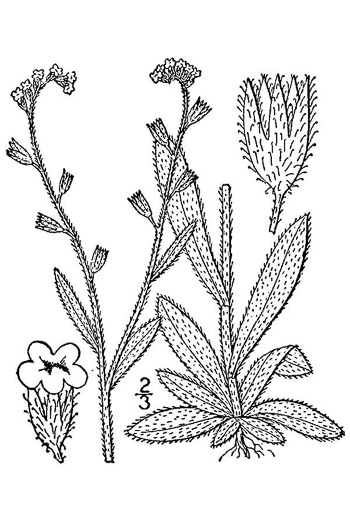Spermatophytes (seed plants): Angiosperms (flowering plants): Eudicots: Core Eudicots: Asterids: Lamiids: Boraginales
WEAKLEY'S FLORA OF THE SOUTHEASTERN US (4/24/22):
Myosotis discolor
FAMILY
Boraginaceae
Go to FSUS key
Dig deeper at SERNEC, a consortium of southeastern herbaria.
Check out EDDMapS.org to see where this has been reported.
Read more about Yellow-and-blue Scorpion-grass at Vascular Plants of North Carolina.
SYNONYMOUS WITH
PLANTS NATIONAL DATABASE:
Myosotis discolor
FAMILY
Boraginaceae
SYNONYMOUS WITH Floristic Synthesis of North America. BONAP (Kartesz, 2021)
Myosotis discolor
SYNONYMOUS WITH VASCULAR FLORA OF THE CAROLINAS (Radford, Ahles, & Bell, 1968) 161-07-007:
Myosotis discolor FAMILY Boraginaceae
(?) Britton & Brown Illus Flora of Northeast US & adjacent Canada (Gleason, 1952)
Myosotis versicolor
COMMON NAME:
Yellow-and-blue Scorpion-grass, Changing Forget-me-not
To see larger pictures, click or hover over the thumbnails.
WEAKLEY'S FLORA OF THE SOUTHEASTERN US (4/24/22):
Myosotis discolor
FAMILY
Boraginaceae
SYNONYMOUS WITH
PLANTS NATIONAL DATABASE:
Myosotis discolor
FAMILY
Boraginaceae
SYNONYMOUS WITH
Floristic Synthesis of North America. BONAP (Kartesz, 2021)
Myosotis discolor
SYNONYMOUS WITH
VASCULAR FLORA OF THE CAROLINAS (Radford, Ahles, & Bell, 1968) 161-07-007:
Myosotis discolor
FAMILY
Boraginaceae
(?)
Britton & Brown Illus Flora of Northeast US & adjacent Canada (Gleason, 1952)
Myosotis versicolor
If a search such as "Carex leptalea var. leptalea" doesn't deliver the results you want, try "Carex leptalea".
Or, to minimize chances of a misspelling, try just "Carex le".
Less is more: If "pencil flower" doesn't deliver the results you want, try "pencil".


